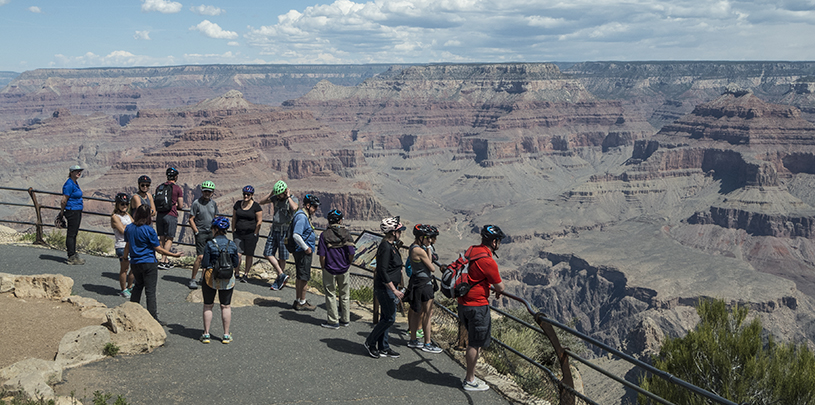
 by Ellen Heyn, Digital Media Director
by Ellen Heyn, Digital Media Director
The Grand Canyon — stretching 277 miles long, one mile deep, and, in places, 18 miles across — is massive. People spend their whole lives hiking the canyon's trails and never see all its nooks and crannies.
So, what should you do if you have only one day at Grand Canyon National Park?
Here are some ideas on how to maximize your visit to the South Rim:
 NPS photo by Michael Quinn
NPS photo by Michael Quinn
Millions of people travel to Grand Canyon National Park each year, making it one of the most visited national parks in the country. To beat the crowds and jump start your day, arrive in time to watch the first light spill over the canyon walls. The ensuing light show makes your pre-dawn wake-up worth it, plus, you’ll get the added bonus of finding a parking space (parking lots often fill by mid-morning). Better yet, go during the off-season (November – February).
When you arrive, follow signs to the visitor center and park your vehicle in lots 1–4. From there, you have a couple options:
Tip: The south rim of the Grand Canyon is 7,000 feet high and gets surprisingly chilly. Bring an extra layer, a thermos of coffee, and perch up. Learn about weather in the Grand Canyon ›

If you can only squeeze one thing into your Grand Canyon visit, it should be this. Hiking is the best way to experience the Grand Canyon. You feel its scale in steep grades. You sense its age in trailside fossils. And you see that the Grand Canyon is more than a pile of rocks. What looks lifeless and barren from afar is full of trees, shrubs, cacti, birds, lizards, and other animals. Here are our top trail picks:
Killer views in under two miles? Yes, please! Descend the initial switchbacks and traverse out to the scenic overlook. Then huff it back up to the trailhead. Expect to spend a couple of hours on the trail. More ›
If your knees aren’t up for hiking switchbacks, walk along the Rim Trail instead. Take the red shuttle bus toward Hermit's Rest, get out at any of the stops, and walk along the trail in either direction. When you get tired, catch a bus back to the village. Here are some of our favorite stretches:
• The Abyss to Hopi Point (2.1 miles)
• Powell Point to Bright Angel Trailhead (1.7 miles)
If you're looking for a challenge, hike the Bright Angel Trail to Plateau Point. You’ll pass the lush oasis of Havasupai Gardens, where Native Americans lived and farmed for thousands of years before Grand Canyon National Park was created. Get an early start, as this is an all-day, rugged hike. Details ›
Note: The park has signs all over reminding you that hiking down is optional; hiking up is mandatory. Hiking in the canyon is often harder than you expect. Be sure to drink water, eat snacks, and listen to your body.
 NPS photo by Michael Quinn
NPS photo by Michael Quinn
How old is the Grand Canyon? How was it formed? How big is it? Find the answers to all your questions and more at the Yavapai Geology Museum. And no need to be a geology buff to enjoy the stop. The small museum features an awesome 3D relief map of the Grand Canyon, fossil displays, and visuals of Earth’s past climates.
How to get there: There is a parking lot at the museum, but avoid traffic congestion by taking the park shuttle bus. From the visitor center, catch the orange “Rim Route” bus, and it will take you right there.

Rather than settle for cafeteria food in the village, brown bag it instead. You can find lunch spots just about anywhere along the Rim Trail, but if you’re willing to spend an extra half hour or so, you can find some primo picnic real estate.
A few gentle reminders: Please don’t feed squirrels, ravens, or other animals looking for handouts. Also, be sure to collect your trash and dispose of it in park trash cans located at all the bus stops and many places within the village.
Find the best picnic spots: From Bright Angel Lodge, take the red shuttle bus toward Hermit's Rest and get out at “The Abyss.” The 1.1-mile stretch of Rim Trail between The Abyss and Mojave Point has at least four picnic tables, each with magnificent canyon views.
Don’t forget the ice cream! After a long day in the sun, treat yourself to an ice cream cone from the Bright Angel Fountain. Located right in the middle of the South Rim hubbub, you’re bound to pass it as some point.
 NPS Photo by Michael Quinn
NPS Photo by Michael Quinn
Desert View Watchtower rises high above the Colorado River. Climb up to the top of the observation deck for 360-degree panoramic views, including the Little Colorado River, the San Francisco Peaks, the Vermilion Cliffs, and Navajo Mountain.
Desert View Watchtower is also a space to learn about the Southwest’s earliest residents and modern affiliated tribes. Inside, murals by Hopi artist Fred Kabotie adorn the walls, and native artists frequently demonstrate their work here. The park service is working on transforming Desert View into a cultural heritage site, including first-voice interpretation.
If you’ve done everything on this list and still have time and energy for more, here are a few extras:
Don't let a little snow keep you from visiting the Grand Canyon. Here's everything you need to know for a winter trip to the big ditch.
Read MoreFind out where to camp beneath the stars in and around Grand Canyon National Park.
Read MoreSettle in to see one of the most awe-inspiring landscapes in the world transform under an expansive, colorful sky.
Read More